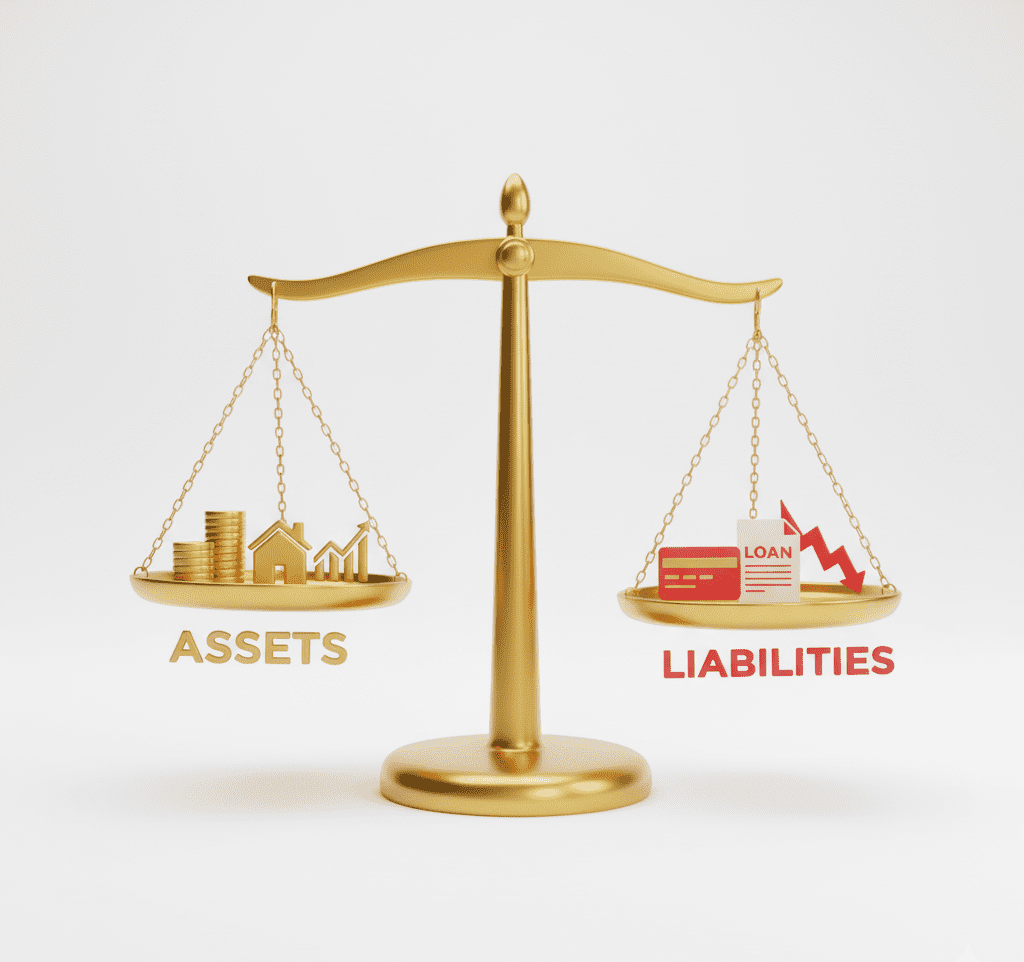I will always remember how scared I was when I sat at my kitchen table in early 2024. Bank statements, credit cards and an ad hoc collection of investment applications were scattered across my desk. I am making good money, yet I could not find the easiest way to answer such a question: “How am I doing, financially? I was like a doctor attempting to diagnose a patient without a stethoscope or any charts and a clear understanding of what being healthy actually was. In this same night I made a ritual that will change my anxiety into empowerment, the annual Financial Check-Up.

What Issue This Guide Addresses.
Financial health is similar to physical health–you cannot pretend it doesn’t exist and hope that later it will become less difficult and easier to manage. A lot of individuals work on a hunch concerning their money. This may be because they think they are doing well since their salary is getting them through the bills, or they experience an underlying, low grade stress, because they realize they are not saving enough but don’t know where to begin.
This guide addresses the issue of ambiguous finances. It gives a systematic, orderly approach to get out of guesswork to knowledge. In a complicated economy of 2026, where interest rates rise and fall, job markets change and digital financial tools emerge, an accurate picture of your financial situation is less of a luxury than a necessity. This check-up will help you:
- Quantify your true net worth.
- Check the strength of your safety net.
- Judge of the weight of your debt.
- Determine the performance of your investments.
- Develop a realistic plan of action within 1 year and more.
- It’s a diagnostic tool giving you a complete picture, therefore, you can cease worrying and start building with authority.
Guided Solution: Your 6-Step 2026 Financial Physical.
Have 2-3 hours of time off. Prepare a list of your large assets, your most recent statements of all bank accounts, investment accounts, loan agreements, credit card bills and a compilation of all your major statements. This is your financial information and we will make sense of it.
Step 1: Find out Your Net Worth (The Ultimate Vital Sign)
The most basic metric of your financial health is your net worth. It is an easy yet effective snapshot.

How to Do It: Create two lists.
- Assets (What You Own): Name all material valuable things. It is cash in your checking or savings account, the balance of your retirement account (401k, IRA), your brokerage investment account, the current market value of your house, the current value of your car (visit a car value site such as Kelley Blue Book), and any other valuables such as jewelry or collectibles.
- Liabilities (What You Ow): Add all your debts. This covers the mortgage balance, car loans balance, student loans balance, credit card debts, personal loans and any other outstanding bill.
The Formula: Your Net Worth = Total Assets, Minus Total Liabilities.
The 2026 Analysis: Don’t count the number. Track it over time. Is it positive and growing? That’s the goal. When it is negative, do not get discouraged because this is where you will start improving. The key is the trend. An increasing net worth is a good sign.
Step 2: Get Your Debt Temperature (The Stress Test)
There is no evil in debt, but unhealthy debt can kill your finances. We must identify its degree of seriousness.
- How to Do It:
- Enter all the debts, their total amount, their interest rate and their minimum monthly payment.
- Divide your debt by your income. Sum up all of your monthly debt obligations (mortgage/rent, car loan, credit card minimums, student loans) and then multiply that by your gross monthly income. Divide by 100 to get a percentage.
Equation: (Total monthly interest payments on debt)/Gross monthly income x 100.
The 2026 Analysis:
- DTI < 36%: Generally healthy.
- DTI between 36%-42%: Caution. You can find it hard to borrow new loans.
- DTI > 43%: Considered high risk. You have a lot of debt that is probably stressing you and narrowing your choices.
- Pay Attention to High-Interest Debt: You must be particularly attentive to debt that carries an interest rate that exceeds 7-8. Credit card debt is especially poisonous in the interest rate environment of 2026.
Step 3: Evaluate Your Emergency Fund (Your Financial Immune System)
This is your emergency fund against a life setback, like a loss of a job, a big car repair, a health emergency.
- How to Do It: Just look at the amount of your special savings account that is not to be spent or invested.
- The 2026 Calculation: The traditional guideline is 3-6 months of a basic cost of living. In this unstable world, a target of 6 months would be much more safe.
- Basic Needs: Housing, electricity, food, transportation, insurance and minimum debt payments.
- Where to Hold It: This savings should be a liquid and secure deposit, in a high-yield savings account (HYSA). Do not invest this money in the stock market to get higher returns; this money is for security and not growth.
Step 4: How is Your Cash Flow (The Pulse of Your Finances)
Your snapshot is your net worth, and your movie is your cash flow. It tells you what is the source of your money and more importantly where it is going.
How to Do It:
- Keep Track of Your Money: Your after-tax income.
- Track Your Spending: In one month, categorize all of your expenses. Budget with a budgeting tool, which is connected to your accounts (such as Monarch, Copilot or YNAB) or with a spreadsheet. They are under the categories Housing, Food (groceries and dining out), Transportation, Utilities, Insurance, Debt Payments, Entertainment, Personal Care, etc.
- The Formula: Monthly Cash Flow = Total Income – Total Expenses.
The 2026 Analysis:
- Positive Cash Flow: Great! This is the cash that you are able to save, invest, or use to make additional debt payments.
- Negative Cash Flow: A red flag. You are living above your means and probably going into debt to sustain your lifestyle. This is the worst point to correct.
Step 5: Examine Your Insurance and Protections (Your Financial Armor)
Fiscal health is shock preparedness. Your main line of defense is insurance.
- How to Do It: Check all your insurance policies and insurance cover.
- Health Insurance: Learn about your deductible and out of pocket maximum.
- Auto/Homeowners/Renters Insurance: Are you well insured against significant losses?
- Disability Insurance: This is perhaps the most ignored one. It safeguards your greatest asset; your income earning capability.
- Life Insurance: You need this when there are people reliant on your earnings.
- The 2026Analysis: Make sure you have sufficient coverage to suit your present life circumstances (e.g., getting married, have a child, buy a house). Shop to make sure that you are not overpaying.
Step 6: Check on Your Investments and Retirement (Planting Trees to Have Shade in Future)
This is regarding taking care of your future self.
How to Do It:
- Balance up all your retiring and investment accounts.
- Are you contributing enough? Another great 2026 benchmark is to strive to save 15-20% of your pre-tax earnings toward retirement.
- Review your Asset Allocation (mixture of stocks, bonds and other assets in your portfolio). Is it within your age and risk tolerance?
The 2026 Analysis:
- Don’t merely consider short-term fluctuations. Consider your long term contribution rate and plan.
- Considering that you may have several old 401 (K)s due to various jobs, it is advisable to combine them into one IRA, to ease their management.
- Make sure you are getting maximum employer matching in your 401(k) – it is free money.
Common Mistakes to Avoid
- Only Checking One Metric: And look at your bank account and tell yourself it’s good enough. A nice bank balance is healthy but when you are ignoring high interest debt or low net worth, you are not seeing the entire picture.
- Being Inconsistent: It is useless to do this once and forget about it. Set your Financial Check-Up date to once a year, and have mini quarterly check-ins about your budget and net worth.
- Calculating Your Expenses too small: When you are monitoring your cash flow, you tend to overlook minor, variable, or annual expenses (such as car registration or holiday gifts). Be cruelly blunt and industrious.
- Using Emotions to make decisions: It can be demoralizing to look at a negative net worth or high debt figure. Don’t let it paralyze you. Make a plan using it as inspirational information. Equally do not make rash changes to investments due to market hype or panic.
- Don’t Leave Your Estate Plan: This is in the realms of financial health care. Make sure to have simple paperwork such as a Will, Durable Power of Attorney and a Directive about your health. This is not a privilege of the rich; but of all.
My Personal Recommendation
In my personal experience of overcoming financial anxiety into control, the only thing that has made a complete shift in my life was adopting a zero-based budgeting application. Personally I use and suggest either YNAB (You Need A Budget) or Monarch Money.
Giving every dollar a job was a ground-breaker philosophy. It made me stop sitting back and simply seeing where my money went, go out there and choose what to do with it. It is this proactive attitude rather than any calculation in the spreadsheet that makes financial health happen. It makes your financial check-up less an autopsy and more a strategic planning session.
Besides, automatizing your financial health should become a routine in 2026. Automatically transfer money to your savings and investment accounts immediately your paycheck clears. It makes wealth building a default, not a choice, and will make you pay yourself first.
(FAQs).
Q: I have a negative net worth. Should I just give up?
Absolutely not. Negative net worth is not the beginning but rather not an end. Virtually all new graduates having student loans inherit a negative net worth. The trick is to develop a strategy to systematically shrink the liabilities (particularly high-interest debt) and develop assets. You should work to make the figure smaller and smaller every year until it turns to the positive.
Q: And how frequently should I have a complete Financial Check-Up?
This type of in-depth check-up should be done once a year. Nevertheless, I highly suggest a mini-check-up every 3 months. Now is the time to update your net worth statement and compare your budget to the amount spent in 15 minutes to make sure you are on track.
Q:Which is the most important number I need to concern myself with?
This is a hard one, but I could pick one, that would be your Monthly Cash Flow. Strong and positive cash flow is the motor that keeps all the other functions of a financially healthy entity. It is the gas you use to accumulate your emergency fund, pay off debt, and invest. Fix your cash flow, but you should fix just one thing.
Q: I’m self-employed. How does this change for me?
Instead the principles change with the focus. Your emergency fund should be more–target 6-12 months of spending because of the fluctuation in income. Planning of your taxes is very important; you have to save quarterly estimated taxes. And disability insurance all the more, when you have no employer to pay you sick leave.
Q: Is there any good equipment to facilitate this?
Yes! Personal capital (since merged to Empower) and mint were traditional examples of net worth trackers, although Monarch Money is becoming a force to reckon with. YNAB, Copilot, and Monarch are great with budgeting and cash flow. To analyze investments, the tools in your brokerage (as in Vanguard, Fidelity, or Charles Schwab) will often be adequate to conduct a personal check-up.

